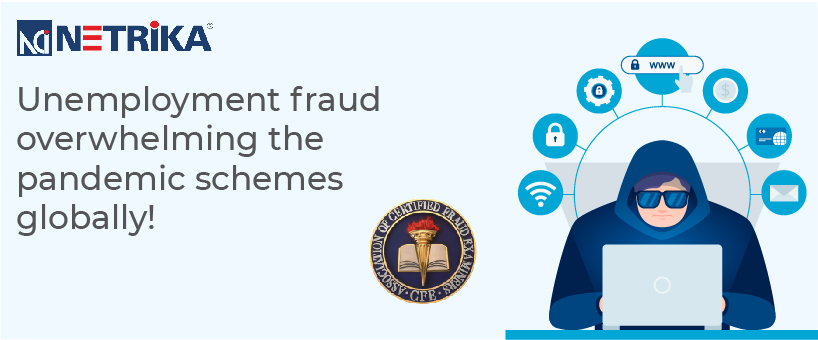Covid-19 outcomes: How it affected unemployment fraud
- April 29, 2022
- Posted by: marketing@netrika.com
- Category: Blogs

An estimated $63 billion was improperly paid out through Covid-19 related unemployment fraud and the statistics are still counting.
Crisis time turning into a fertile ground for fraudsters
COVID-19 pandemic proved to be this century’s biggest catastrophe affecting billions across the world and leaving millions of families stranded and on the verge of collapse. While the world was fighting this biggest battle of our time, there was another ramification breeding deep in the ongoing aftermath of the pandemic.
Government schemes during a crisis have always been a breeding ground for scammers who thrive on the vulnerabilities imposed by health and economic impacts. But the intensity by which the Covid-19 unemployment program fraud scaled a staggering level was beyond comparison to any other crisis.
While local and state governments are putting programs to shoulder the burden of these trying times, easing the financial hardships for the general public, fraudsters tend to take it otherwise. Their approach to unprecedented situations is an opportunity for penetrating the vulnerable verticals and crippling public welfare funds.
While unemployment funds have been rampant for the longest time and change every time governments change policies, the existence of unemployment fraud has accompanied these programs. However, the problem has scaled to new heights with the inclusion of the digital landscape in identifying, allocating, and managing funds. While easing the fund allocation process, scammers exploit technology through sophisticated methods to act on their tactics.
So, let us understand the unique nature of the unemployment fraud landscape during the financial crisis with constantly changing characteristics:
Fraudulent first-time claimants
To claim the benefits, fraudsters have been filing first-time claims by stealing identities. It is a common practice adopted by scammers to steal the identities and social security details of incarcerated, out-of-state and deceased individuals.
Benefit-wage conflicts
Most individuals who lose their jobs during unprecedented situations tend to find another when countries re-open their economies. So, while these people get unemployment benefits during the crisis, they either fail to inform when things get back on track or choose not to disclose their employment status. They collect their benefit wages simultaneously obtaining the new job salary. This is considered to be one of the most common unemployment benefit abuses, which leads to overpayment, affecting the economy.
Fictitious business scams
Fraudsters usually choose a two-sided tactic to steal from unemployment benefit programs. For instance, they might create a shell business, hire fictitious employees and steal employment benefits. During the pandemic, fraudsters became common practice wherein they would obtain the benefits of both employer and employee by using stolen and fictitious identities.
Besides these common unemployment benefit scheme frauds circumventing the legal process, there were other activities that fraudsters made use of during Covid-19 where the dark web was involved. For example, scammers would buy stolen identities via the dark web, fill out unemployment claims using that information and receive unemployment benefits to a drop account.
One might question how fraudsters take these steps so easily at scale despite multiple layers of security shields? The answer to it is significantly simple- a storm of the Covid-19 pandemic scale is the perfect opportunity for fraudsters to facilitate their scams, masquerading as authentic victims. With the world focussing on managing crises, such fraudsters evade policies and target the most vulnerable zones.
What are the behavioral indications of unemployment fraud?
“Unemployment fraud is associated with several fraudulent activities, including identity theft, money laundering, and synthetic identity.”
Behavior spread across the following categories is an indicator of unemployment fraud:
● Device signals with unusual time zones, multiple users logging from the same device, and recognizing digital and device users online.
● Network Signals in unusual countries, where autonomous system number (ASN) is located in hosting environments and the time associated with it is also unusual.
● Environment spoofing signals with transactions via anonymizing proxies, VPN, or other technologies that are specifically designed to spoof or hide environments. It also involves multiple similar transactions from the same device. Previously unique or unseen browser fingerprints are also an environmental indicator with minute changes in the system or device’s identity, integrity, and legitimacy identified through browser interrogation.
● Behavior signals include typing patterns, such as typing speed, suspicious massive copy-paste, and pressing keys. It also involves the browse window only occupying a part of the screen and mouse movement, indicating copy-pasting besides the browser window.
Unemployment program frauds create a dire situation with immediate action demands, owing to the intensity of impact. However, with some straightforward steps and slight vigilance, authorities can easily identify, track and manage such frauds.
Situations that reflect unemployment fraud can be detected and prevented:
While staying vigilant is the best method to prevent unemployment fraud, it is not the easiest task performed during a crisis. However, identifying the following situations and reporting them might contain the fraud the instant.
● If a great number of unemployment applications are received from the same email address or device.
● Suspicious user behavior patterns such as copying and pasting when interacting with the site, submitting unemployment applications quickly, navigating the website swiftly and showing a high degree of familiarity, referencing another browser window constantly, attempting to evade detection by using cloud or VPN, submitting multiple applications and completing the same form multiple times from the same device.
● More than one unemployment benefit heading to the same drop account.
● More than one unemployment claim by the same physical/permanent home address.
Netrika joins the crisis management force by lending its training to help avert fraud and monitor fund allocation!
Netrika, with its extensive list of training programs, collaborates with ACFE India, to deliver the CFE certificate examination course across industry verticals. We are a global leader in offering specialized training regimes from experts in the respective areas of specialization with comprehensive industry exposure.
Our CFE certificate course allows the participant to gain professional visibility and credibility while enhancing their marketability and job security across the globe. With an instructor-led CFE training course, Netrika empowers and generates awareness for both a professional and the organization to impede potential frauds and limit the risk of having already impacted the entity.

